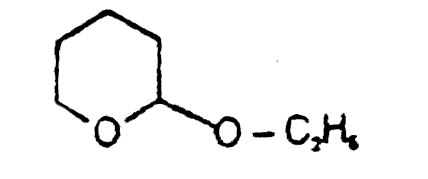The products obtained on hydrolysis of superoxide
MO2+H2O→M++OH−+H2O2
MO2+H2O→M++OH−+H2O
MO2+H2O→M++OH−+H2O2+O2
MO2+H2O→M++OH−
The correct Answer is:C
To solve the question regarding the products obtained on hydrolysis of superoxide, we can follow these steps:
1. Identify the Superoxide Ion:
Superoxides are compounds that contain the superoxide ion (O2^-). This ion is characterized by having one extra electron compared to the normal diatomic oxygen molecule (O2).
2. Write the General Formula for Superoxide:
The general formula for a superoxide can be represented as MO2, where M is a metal cation. For example, potassium superoxide can be represented as KO2.
3. Understand Hydrolysis:
Hydrolysis refers to the reaction of a substance with water. In this case, we are looking at the reaction of superoxide with water.
4. Write the Hydrolysis Reaction:
When superoxide (MO2) reacts with water (H2O), the products formed are:
- A hydroxide (M+OH^-)
- Hydrogen peroxide (H2O2)
- Oxygen gas (O2)
The balanced reaction can be represented as:
2MO2+2H2O→2M++2OH−+H2O2+O2
5. Example with Potassium Superoxide:
For potassium superoxide (KO2), the hydrolysis reaction can be written as:
2KO2+2H2O→2KOH+H2O2+O2
6. Conclusion:
The products of the hydrolysis of superoxide are hydroxide ions (M+OH^-), hydrogen peroxide (H2O2), and oxygen gas (O2).
Final Answer:
The products obtained on hydrolysis of superoxide are:
- Hydroxide ions (M+OH^-)
- Hydrogen peroxide (H2O2)
- Oxygen gas (O2)
---
Superoxides are compounds that contain the superoxide ion (O2^-). This ion is characterized by having one extra electron compared to the normal diatomic oxygen molecule (O2).
The general formula for a superoxide can be represented as MO2, where M is a metal cation. For example, potassium superoxide can be represented as KO2.
Hydrolysis refers to the reaction of a substance with water. In this case, we are looking at the reaction of superoxide with water.
When superoxide (MO2) reacts with water (H2O), the products formed are:
- A hydroxide (M+OH^-)
- Hydrogen peroxide (H2O2)
- Oxygen gas (O2)
2MO2+2H2O→2M++2OH−+H2O2+O2
For potassium superoxide (KO2), the hydrolysis reaction can be written as:
2KO2+2H2O→2KOH+H2O2+O2
The products of the hydrolysis of superoxide are hydroxide ions (M+OH^-), hydrogen peroxide (H2O2), and oxygen gas (O2).
The products obtained on hydrolysis of superoxide are:
- Hydroxide ions (M+OH^-)
- Hydrogen peroxide (H2O2)
- Oxygen gas (O2)
Topper's Solved these Questions
- CHEMISTRY AT A GLANCEBOOK - ALLENCHAPTER - CHEMISTRY AT A GLANCEEXERCISE - ORGANIC CHEMISTRY
472 Videos
- CHEMISTRY AT A GLANCEBOOK - ALLENCHAPTER - CHEMISTRY AT A GLANCEEXERCISE - ORGANIC CHEMISTRY
472 Videos
- Chemical EquilibriumBOOK - ALLENCHAPTER - Chemical EquilibriumEXERCISE - All Questions
30 Videos
- ELECTROCHEMISTRYBOOK - ALLENCHAPTER - ELECTROCHEMISTRYEXERCISE - EXERCISE -05 [B]
38 Videos
Similar Questions
Knowledge Check
 , Product obtained is :A
, Product obtained is :A B
B C
C DNone of these
DNone of these , Products obtained are : ARacenicBDiastereomersCG.IDPositional isomers
, Products obtained are : ARacenicBDiastereomersCG.IDPositional isomers
The product obtained on alkaline hydrolysis of fats
View SolutionWhat are the products obtained on complete hydrolysis of DNA ? Write down the structure of pyrimidine and purine bases present in DNA.
View SolutionThe product obtained by the hydrolysis of the adduct formed by the reaction of ethyl magnesium iodide with methanal can also be prepared by the following reaction
View SolutionThe product obtained by the hydrolysis of the adduct formed by the reaction of ethyl magnesium iodide with methanal can also be prepared by which of the following reaction?
View Solution
The product obtained is/are
View SolutionThe products of acid hydrolysis of P and Q can be distinguished by

View Solution

